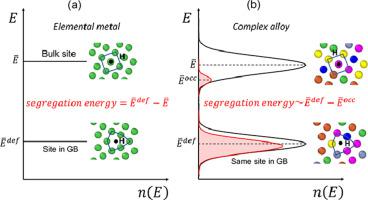当前位置:
X-MOL 学术
›
Acta Mater.
›
论文详情
Our official English website, www.x-mol.net, welcomes your feedback! (Note: you will need to create a separate account there.)
First Principles Study of the Effect of Hydrogen in Austenitic Stainless Steels and High Entropy Alloys
Acta Materialia ( IF 9.4 ) Pub Date : 2020-11-01 , DOI: 10.1016/j.actamat.2020.09.070 Xiao Zhou , William A. Curtin
Acta Materialia ( IF 9.4 ) Pub Date : 2020-11-01 , DOI: 10.1016/j.actamat.2020.09.070 Xiao Zhou , William A. Curtin

|
Abstract Hydrogen (H) embrittlement in multicomponent austenitic alloys is a serious limitation to their application in many environments. Recent experiments show that the High-Entropy Alloy (HEA) CoCrFeMnNi absorbs more H than 304 Stainless Steel but is less prone to embrittlement while the HEA CoCrFeNi is not embrittled under comparable conditions. As a first step toward understanding H embrittlement, here a comprehensive first-principles study of H absorption, surface, and fracture energies in the presence of H is presented for 304 Stainless Steel, 316 Stainless Steel, CoCrFeNi, and CoCrFeMnNi. A collinear paramagnetic model of the magnetic state is used, which is likely more realistic than previous proposed magnetic states. All alloys have a statistical distribution of H absorption sites. Hence, at low concentrations, H is effectively trapped in the lattice making it more difficult for H to segregate to defects or interfaces. Agreement with experimental H solubilities across a range of chemical potentials can be achieved with minor fitting of the average H absorption energy. The (111) surface energies for 0, 50, and 100% H surface coverage are very similar across all alloys. The fracture energies for two representative thermodynamic conditions are then determined. SS304 and CoCrFeNi are found to have the lowest fracture energies, but experiments suggest rather different embrittlement tendencies. These results indicate that differences in H embrittlement across these austenitic alloys are not due solely to differences in H absorption or H-reduced fracture energy, thus requiring more sophisticated concepts than those recently found successful for fcc Ni.
中文翻译:

氢对奥氏体不锈钢和高熵合金影响的第一性原理研究
摘要 多组分奥氏体合金中的氢 (H) 脆化严重限制了其在许多环境中的应用。最近的实验表明,高熵合金 (HEA) CoCrFeMnNi 比 304 不锈钢吸收更多的 H,但不易脆化,而 HEA CoCrFeNi 在可比条件下不会脆化。作为了解 H 脆化的第一步,这里对 304 不锈钢、316 不锈钢、CoCrFeNi 和 CoCrFeMnNi 进行了 H 存在下 H 吸收、表面和断裂能的综合第一性原理研究。使用了磁态的共线顺磁模型,这可能比之前提出的磁态更现实。所有合金都具有 H 吸收位点的统计分布。因此,在低浓度下,H 被有效地困在晶格中,使 H 更难分离到缺陷或界面。通过对平均 H 吸收能量进行较小的拟合,可以实现在一系列化学势上与实验 H 溶解度的一致性。0、50 和 100% H 表面覆盖率的 (111) 表面能在所有合金中都非常相似。然后确定两种代表性热力学条件的断裂能。SS304 和 CoCrFeNi 被发现具有最低的断裂能,但实验表明脆化趋势相当不同。这些结果表明,这些奥氏体合金 H 脆性的差异不仅仅是由于 H 吸收或 H 减少断裂能的差异,因此需要比最近发现的 fcc Ni 成功的概念更复杂的概念。
更新日期:2020-11-01
中文翻译:

氢对奥氏体不锈钢和高熵合金影响的第一性原理研究
摘要 多组分奥氏体合金中的氢 (H) 脆化严重限制了其在许多环境中的应用。最近的实验表明,高熵合金 (HEA) CoCrFeMnNi 比 304 不锈钢吸收更多的 H,但不易脆化,而 HEA CoCrFeNi 在可比条件下不会脆化。作为了解 H 脆化的第一步,这里对 304 不锈钢、316 不锈钢、CoCrFeNi 和 CoCrFeMnNi 进行了 H 存在下 H 吸收、表面和断裂能的综合第一性原理研究。使用了磁态的共线顺磁模型,这可能比之前提出的磁态更现实。所有合金都具有 H 吸收位点的统计分布。因此,在低浓度下,H 被有效地困在晶格中,使 H 更难分离到缺陷或界面。通过对平均 H 吸收能量进行较小的拟合,可以实现在一系列化学势上与实验 H 溶解度的一致性。0、50 和 100% H 表面覆盖率的 (111) 表面能在所有合金中都非常相似。然后确定两种代表性热力学条件的断裂能。SS304 和 CoCrFeNi 被发现具有最低的断裂能,但实验表明脆化趋势相当不同。这些结果表明,这些奥氏体合金 H 脆性的差异不仅仅是由于 H 吸收或 H 减少断裂能的差异,因此需要比最近发现的 fcc Ni 成功的概念更复杂的概念。



























 京公网安备 11010802027423号
京公网安备 11010802027423号